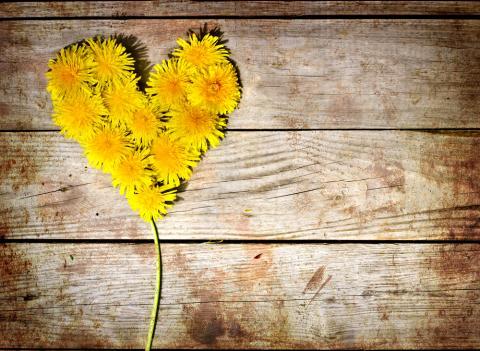
While others curse its arrival in spring, I applaud it. The spunky little dandelion is a first flower for nectar-hunting honeybees. It pains me to see homeowners yank it from their yards, not only because they are eradicating an important food source for pollinating insects, but because the little plants can offer so much before their fluffy seeds are scattered to the wind!
The dandelion (Taraxacum officinale) is a perennial, blooming in early spring and throughout the summer. The bright yellow head is actually made up of more than 100 individual flowers, with each flower producing a seed. Each time you pluck a dandelion, you are picking an entire bouquet of flowers!
The sun-loving dandelion closes up at night and on dark, rainy days. When the seeds are ready to fly, the stalk becomes upright, allowing the slightest breeze to catch the fluffy parachutes and start their adventure. The seeds have been known to attach themselves to cargo and travel overseas, adapting to whatever environment they encounter.
In fact, the dandelion is a true survivor. It has a bitter taste that repels grazing sheep or other animals, and its taproot can travel four to five feet underground. Just try eliminating them from your lawn.
But it is not just a weed. The iron-rich plant is full of vitamins – A, B, C and D. The young spring leaves can be picked and added to salads and soups, and herbalists use the dried root to treat liver and gallbladder problems. Folk remedy fans say the plant has been used to treat anemia, scurvy, rashes and even depression (really, it makes me happy just to look at them!). Others say the dried roots of the dandelion can be used as a coffee substitute.
I’m not ready to give up my coffee. But I can tell you that I have made a sweet tea from the yellow flowers. Boil two cups of clean flower heads (remove every bit of green!) in about 4 cups of water. Strain, and add 1 cup of sugar or honey. Stir well. Add the juice of one large lemon and cook over a low heat, stirring well, until the liquid thickens to a syrup consistency. The syrup can be added to tea or poured over pancakes. It is believed to help with digestion, act as a diuretic, and give you energy. If you’d like something a little stronger, you could make dandelion wine.
You can collect wild dandelions, but make sure you choose an area that has not been sprayed with pesticides or fertilizers. Or you can grow them yourself - who cares what the neighbors think! Health food stores often carry frozen leaves and tinctures.
A caveat: if you have an allergy to ragweed, yarrow, marigold and chamomile, you may also experience an allergic reaction to dandelion. Always consult your health care professional before introducing a new herb or plant into your diet, to avoid adverse effects.
What’s the best thing about dandelions? The wishes!








